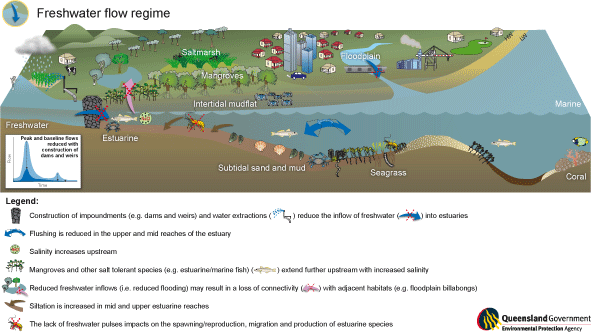Our current best conceptual understanding of the stressor ‘freshwater flow regime’ is shown in Figure 1.
Figure 1. Potential causes of a change to freshwater flow regime and the condition responses observed as a result of this change.
Construction of impoundments on many Australian rivers has resulted in altered (and in virtually all cases this means reduced) freshwater inflows to estuaries. This has impacts on estuarine productivity, on fish breeding cycles, on siltation in upper estuary areas, on salinity and on dispersion of pollutants.
The main elements of a freshwater inflow regime are quantity (magnitude), temporal pattern (frequency, duration, timing and rate of change) and quality. As such, any alterations to flow characteristics can be assessed using a range of measures. It is important to consider these different measures as they have different effects on estuaries. Two of the most important characteristics to consider for estuaries are:
- reductions in the duration of base inflows; and
- reductions in the frequency and size of large inflows.
There is clear evidence from around the world that alterations to freshwater flow regime affect the geochemical processes, water quality and abiotic habitats of estuaries. The key estuarine physical-chemical conditions that might be affected by altered flow regimes include:
- salinity,
- sediment/turbidity,
- water temperature,
- nutrients and organic matter,
- dissolved oxygen,
- pH,
- hydrodynamics – including water velocity, shear stress, mixing and circulation patterns,
- geomorphology and abiotic habitat; and
- connectivity.
In terms of biological condition changes; migration/dispersal, spawning, growth, survival and recruitment are thought to be the main mechanisms affected.
Interactions between natural and managed flows (additive or subtractive), groundwater recharge and climate (rainfall) patterns are natural mediating factors which influence the impact of an altered freshwater flow regime on the ecosystem.



